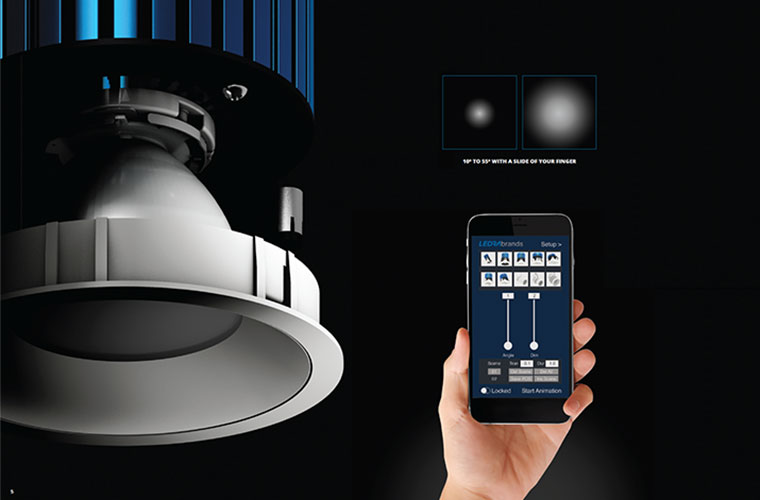At Lightfair’s Innovation Awards ceremony in Chicago, LEDRA Brands’ VECTOR Downlight received the coveted Most Innovative Product of the Year Award for 2018.
The Vector system introduces a solid-state lensing system, which allows dynamic beam shaping adjustable from 10O to 55O. It uses a liquid crystal layer to achieve the adjustable lens. The lens has no moving parts and achieves this function by making use of molecular reorientation in the liquid crystal to allow electronic control of the lens’ focus.
In the past, most downlight fixtures came from the factory with a fixed beam angle. As point lighting, the need for LEDs has rested on two options: either use a mechanical system with moving optical components or use multiple LEDs aimed at fixed points which could be activated in patterns to achieve a beam shaping.
The multi-LED approach limited the output of the downlight since not all LEDs were illuminated all the time. As such, specifying for distributors could be difficult based on total output versus actual light produced at a given angle.
“OmniPoint adds 61 LEDs to a center of a room all pointed in different directions and then dimmed or turned on or off,” notes LEDRA Technology manager Shawn Keeney. “Vector Series is a smooth dynamic, individual light creating an environment, not manipulating it.”
Smartphones are usually the genesis of innovation in technology, especially in improving quality in small applications. It was no different with the solution first introduced for cameras by LensVector a few years ago. Shawn Keeney, engineering manager at LEDRA, pointed to the company as an example of a pioneering use of the technology.
Then, they used a liquid crystal cell to create a variable focus lens, which led to a reduction of 80 percent in power consumption compared to mechanical lenses used in existing phones. Given the increased number of cameras available on most phones, now up to one front-facing and two rear-facing, the need for cost reductions was clear when units sold reached the tens of millions mark.
Smartphone connectivity was crucial to the success of the program. “Casambi [one of the few lighting control apps that is available for both iOS and Android devices] stepped up to integrate a dual control to handle the beam angle and light level settings in a single app,” said Keeney.
End-user simplicity is a key factor in any lighting solution, of course, but the benefits of the technology come from both the app and the underlying technology. By adjusting the throw from 10 degrees to 55 degrees, lighting designers can create multi-use environments without specifying more fixtures or trying to run the numbers on luminaires that rely on turning on portions of the available LEDs that reduce total lumens output at the expense of versatility.
The impact on the lighting marketplace for this new technology should be significant. In retail applications, where retrofits are typically ongoing as marketing campaigns change, having the ability to reshape downlight output will be valuable. Likewise, for sections of museums with changing displays, the ability to reshape downlight output based on the positions and sizes of the art will be very useful.
In commercial office spaces, the trend is to emphasize task lighting for office workers. Allowing workers to adjust the focus of the downlights in their space provides one more tool in the personal lighting toolbox with the ultimate goal of employee retention. It also may work to provide more information regarding efficiency to connected systems using IPV6 or BACnet technology based on usage.
Keeney added, in a recent interview, that life sciences is another potential sector for growth that distributors could benefit from as it continues to focus on human-centric lighting options.
The cost of the products may be higher than competitors’ alternatives, but the adjustable beam-spread downlight means fewer SKUs, with a corresponding reduction in inventory cost and increase in product availability.
The reduction in SKUs is a major goal of competing luminaire manufacturers. When distributors have to maintain massive databases of options for end-users, it leads to headaches and friction. Manufacturers still build to order in many instances, and even when they don’t, it can be mind-numbing to try and navigate the landscape.
lightED knows of at least one manufacturer that is taking a similar tack in reducing the number of SKUs in its offerings. Trying to streamline the process improves the likelihood that the distributors find the right fit for their client needs and for manufacturers to limit the number of different SKUs.
And distributors who may be considering more expensive options like direct displays or OLEDs, now have another option to bring to lighting designers.
Tagged with beam shaping, innovation, LEDRA, lightED, Lightfair
